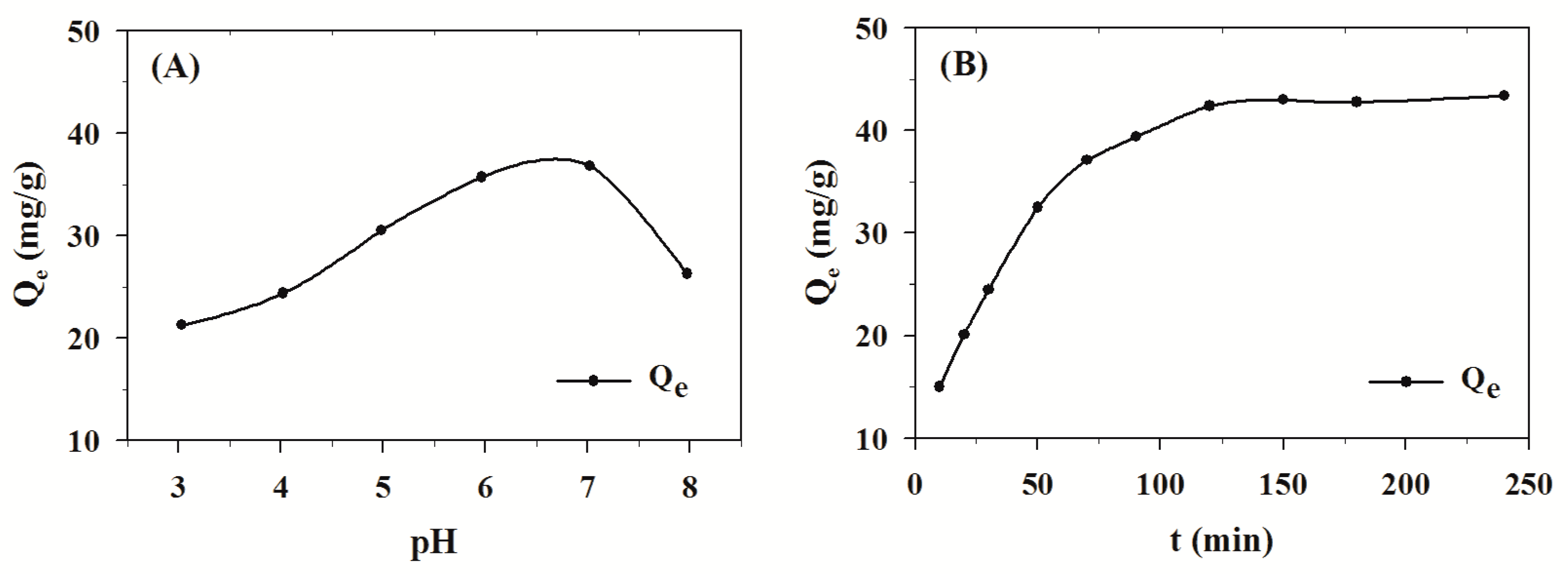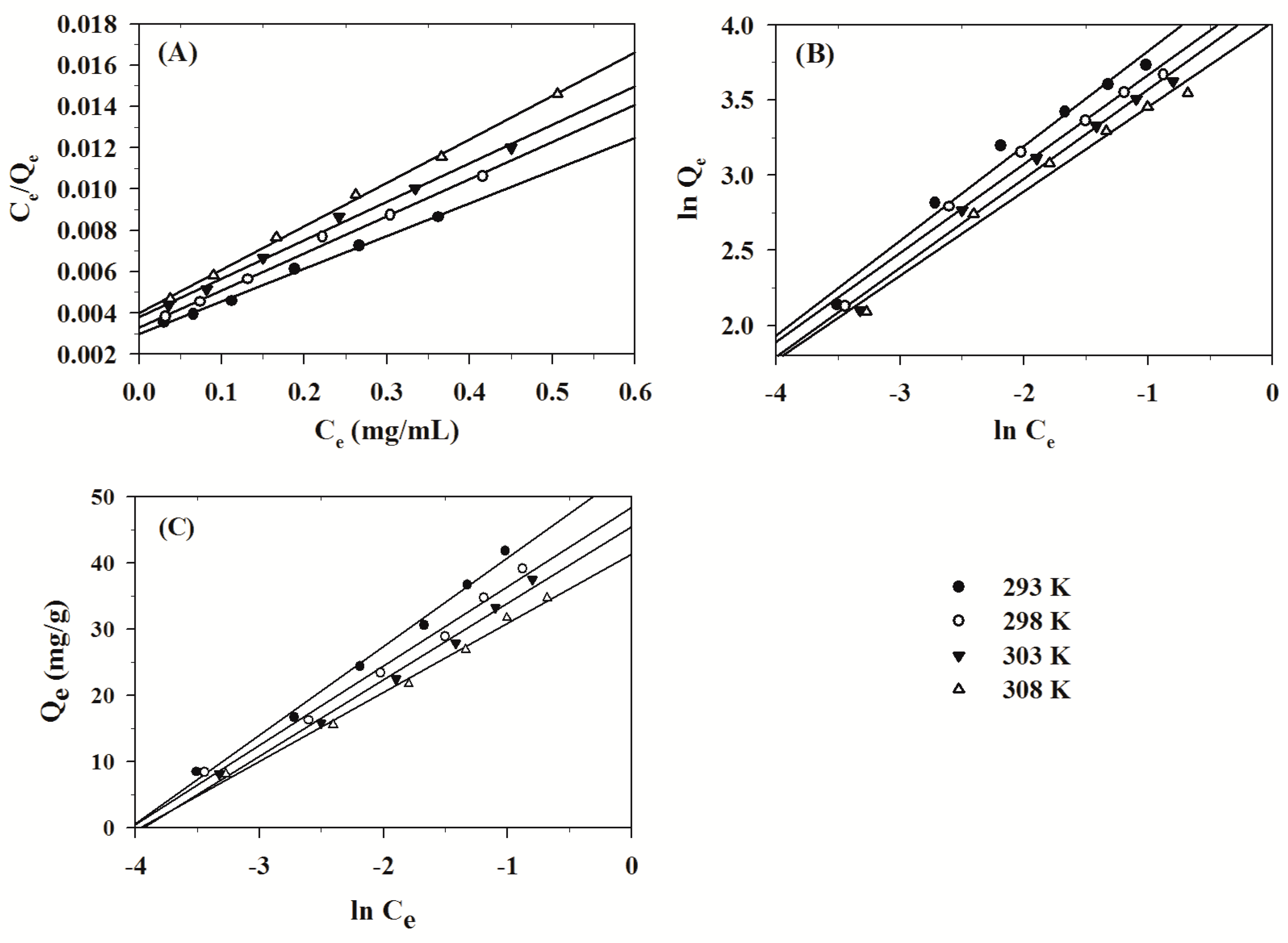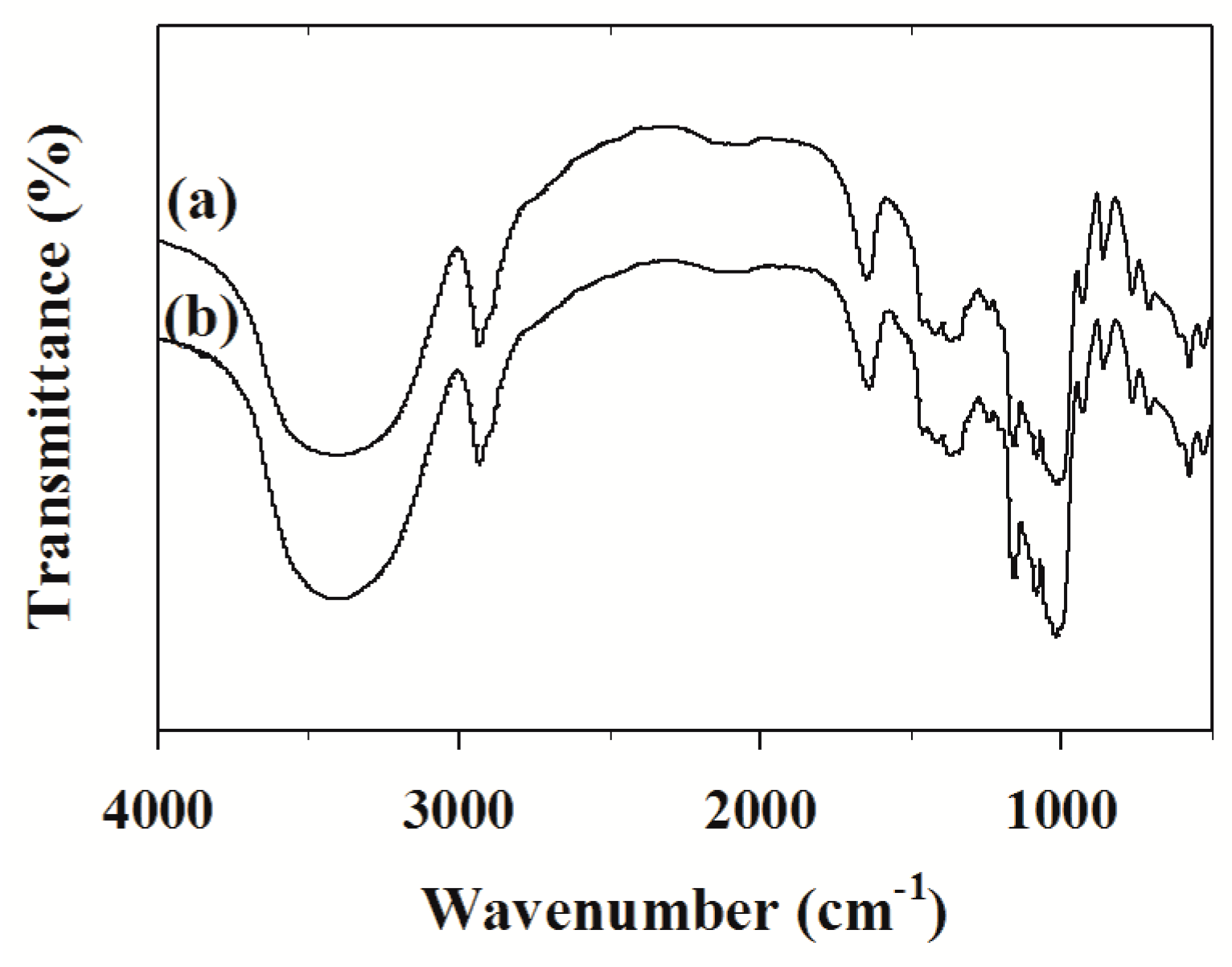Adsorption of Tea Polyphenols using Microporous Starch: A Study of Kinetics, Equilibrium and Thermodynamics
Abstract
1. Introduction
2. Results and Discussion
2.1. Effect of pH
2.2. Effect of Contact Time
2.3. Adsorption Kinetics
2.3.1. Pseudo First-Order Model
2.3.2. Pseudo Second-Order Model
2.3.3. Weber and Morris Intra-Particle Diffusion Model
2.4. Adsorption Isotherm
2.4.1. Langmuir Isotherm
2.4.2. Freundlich Isotherm
2.4.3. Tempkin Isotherm
2.5. Thermodynamic Study of Adsorption
2.6. The Stability of Microporous Starch (MPS)-Loaded Tea Polyphenols (TPS)
2.7. Characterization of the Adsorbents
3. Materials and Methods
3.1. Materials
3.2. Preparation of Microporous Starch
3.3. Determination of Tea Polyphenols Content
3.4. Batch Adsorption Experiments
3.5. The Stability Evaluation of MPS-Loaded TPS
3.6. Characterization Methods
4. Conclusions
Author Contributions
Funding
Conflicts of Interest
References
- Vuong, Q.V.; Golding, J.B.; Nguyen, M.; Roach, P.D. Extraction and isolation of catechins from tea. J. Sep. Sci. 2010, 33, 3415–3428. [Google Scholar] [CrossRef] [PubMed]
- Hashimoto, F.; Ono, M.; Masuoka, C.; Ito, Y.; Sakata, Y.; Shimizu, K.; Nishioka, I.; Nohara, T. Evaluation of the anti–oxidative effect (in vitro) of tea polyphenols. Biosci. Biotech. Bioch. 2003, 67, 396–401. [Google Scholar] [CrossRef]
- Balasundram, N.; Sundram, K.; Samman, S. Phenolic compounds in plants and agri–industrial by–products: Antioxidant activity, occurrence, and potential uses. Food Chem. 2006, 99, 191–203. [Google Scholar] [CrossRef]
- Ide, K.; Matsuoka, N.; Yamada, H.; Furushima, D.; Kawakami, K. Effects of tea catechins on Alzheimer’s disease: Recent updates and perspectives. Molecules 2018, 23, 2357. [Google Scholar] [CrossRef]
- Shirakami, Y.; Shimizu, M. Possible mechanisms of green tea and its constituents against cancer. Molecules 2018, 23, 2284. [Google Scholar] [CrossRef]
- Gramza, A.; Korczak, J.; Amarowicz, R. Tea polyphenols–their antioxidant properties and biological activity–a review. Pol. J. Food Nutr. Sci. 2005, 14, 219–235. [Google Scholar]
- Mukhtar, H.; Ahmad, N. Tea polyphenols: Prevention of cancer and optimizing health. Am. J. Clin. Nutr. 2000, 71, 1698–1702. [Google Scholar] [CrossRef]
- Yan, H.; Zhengbiao, G.U. Morphology of modified starches prepared by different methods. Food Res. Int. 2010, 43, 767–772. [Google Scholar] [CrossRef]
- Wang, X.Y.; Wang, H.Q.; Dai, Q.F.; Li, Q.Y.; Yang, J.H.; Zhang, A.N.; Yan, Z.X. Preparation of novel porous carbon spheres from corn starch. Colloid Surface A 2009, 346, 213–215. [Google Scholar]
- Yao, W.R.; Yao, H.Y. Adsorbent characteristics of porous starch. Starch/Starke 2002, 54, 260–263. [Google Scholar]
- Gao, F.; Li, D.; Bi, C.H.; Mao, Z.H.; Adhikari, B. Application of various drying methods to produce enzymatically hydrolyzed porous starch granules. Dry Technol. 2013, 31, 13–14. [Google Scholar] [CrossRef]
- Chen, Y.S.; Huang, S.R.; Tang, Z.F.; Chen, X.W.; Zhang, Z.F. Structural changes of cassava starch granules hydrolyzed by a mixture of α–amylase and glucoamylase. Carbohyd. Polym. 2011, 85, 272–275. [Google Scholar] [CrossRef]
- Dura, A.; Błaszczak, W.; Rosell, C.M. Functionality of porous starch obtained by amylase or amyloglucosidase treatments. Carbohyd. Polym. 2014, 101, 837–845. [Google Scholar] [CrossRef] [PubMed]
- Chen, G.; Zhang, B. Hydrolysis of granular corn starch with controlled pore size. J. Cereal Sci. 2012, 56, 316–320. [Google Scholar] [CrossRef]
- Glenn, G.M.; Klamczynski, A.P.; Woods, D.F.; Chiou, B.; Orts, W.J.; Imam, S.H. Encapsulation of plant oils in porous starch microspheres. J. Agr. Food Chem. 2010, 58, 4180–4184. [Google Scholar] [CrossRef] [PubMed]
- Nagata, K.; Okamoto, H.; Danjo, K. Naproxen particle design using porous starch. Drug Dev. Ind. Pharm. 2001, 27, 287–296. [Google Scholar] [CrossRef] [PubMed]
- Belingheri, C.; Curti, E.; Ferrillo, A.; Vittadini, E. Evaluation of porous starch as a flavour carrier. Food Funct. 2012, 3, 255–261. [Google Scholar] [CrossRef] [PubMed]
- Zeller, B.L.; Saleeb, F.Z.; Ludescher, R.D. Trends in development of porous carbohydrate food ingredients for use in flavor encapsulation. Trends Food Sci. Tech. 1998, 9, 389–394. [Google Scholar] [CrossRef]
- Ding, L.; Deng, H.P.; Wu, C.; Han, X. Affecting factors, equilibrium, kinetics and thermodynamics of bromide removal from aqueous solutions by MIEX resin. Chem. Eng. J. 2012, 181–182, 360–370. [Google Scholar] [CrossRef]
- Chen, Y.Y.; & Zhang, D.J. Adsorption kinetics, isotherm and thermodynamics studies of flavones from Vaccinium bracteatum Thunb leaves on NKA–2 resin. Chem. Eng. J. 2014, 254, 579–585. [Google Scholar] [CrossRef]
- Chen, H.; Wang, C.; Ye, J.; Zhou, H.; Tao, R.; Li, W. Preparation of starch-hard carbon spherules from ginkgo seeds and their phenol-adsorption characteristics. Molecules 2018, 23, 96. [Google Scholar] [CrossRef]
- Qian, W.B.; Lin, X.Q.; Zhou, X.Q.; Chen, X.C.; Xiong, J.; Bai, J.X.; Ying, H.J. Studies of equilibrium, kinetics simulation and thermodynamics of cAMP adsorption onto an anion–exchange resin. Chem. Eng. J. 2010, 165, 907–915. [Google Scholar] [CrossRef]
- Zhang, L.M.; Cai, W.T.; Shan, J.; Zhang, S.; Dong, F. Physical properties and loading capacity of gelatinized granular starches. Ind. Crop Prod. 2014, 53, 323–329. [Google Scholar] [CrossRef]
- Baycin, D.; Altiok, E.; Ulkü, S.; Bayraktar, O. Adsorption of olive leaf (Olea europaea L.) antioxidants on silk fibroin. J. Agr. Food Chem. 2007, 55, 1227–1236. [Google Scholar] [CrossRef]
- Yoon, S.Y.; Choi, W.J.; Park, J.M.; Yang, J.W. Selective adsorption of flavonoid compounds from the leaf extract of Ginkgo biloba L. Biotechnol. Tech. 1997, 11, 553–556. [Google Scholar] [CrossRef]
- Wang, X.M.; Yuan, X.J.; Han, S.; Zha, H.W.; Sun, X.C.; Huang, J.H.; Liu, Y.N. Aniline modified hypercrosslinked polystyrene resins and their adsorption equilibriums, kinetics and dynamics towards salicylic acid from aqueous solutions. Chem. Eng. J. 2013, 233, 124–131. [Google Scholar] [CrossRef]
- Ahmaruzzaman, M. Adsorption of phenolic compounds on low–cost adsorbent: A review. Adv. Colloid Interfac. 2008, 143, 48–67. [Google Scholar] [CrossRef]
- Lagergren, S. About the theory of so called adsorption of solute substances. Ksver Veterskapsakad Handling 1898, 24, 1–6. [Google Scholar]
- Mahmoud, H.R.; Ibrahim, S.M.; El-Molla, S.A. Textile dye removal from aqueous solutions using cheap MgO nanomaterials: Adsorption kinetics, isotherm studies and thermodynamics. Adv. Powder Technol. 2016, 27, 223–231. [Google Scholar] [CrossRef]
- Ho, Y.S. Pseudo–second order model for sorption processes. Process Biochem. 1999, 34, 451–465. [Google Scholar] [CrossRef]
- Gao, Z.P.; Yu, Z.F.; Yue, T.L.; Quek, S.Y. Adsorption isotherm, thermodynamics and kinetics studies of polyphenols separation from kiwifruit juice using adsorbent resin. J. Food Eng. 2013, 116, 195–201. [Google Scholar] [CrossRef]
- Ho, Y.S.; McKay, G. Competitive sorption of copper and nickel ions from aqueous solution using peat. Asorption 1999, 5, 409–417. [Google Scholar] [CrossRef]
- Shi, Y.; Kong, X.Z.; Zhang, C.M.; Chen, Y.M.; Hua, Y.F. Adsorption of soy isoflavones by activated carbon: Kinetics, thermodynamics and influence of soy oligosaccharides. Chem. Eng. J. 2013, 215–216, 113–121. [Google Scholar] [CrossRef]
- Vasiliu, S.; Bunia, I.; Racovita, S.; Neagu, V. Adsorption of cefotaxime sodium salt on polymer coated ion exchange resin microparticles: Kinetics, equilibrium and thermodynamic studies. Carbohyd. Polym. 2011, 85, 376–387. [Google Scholar] [CrossRef]
- Tsai, W.T.; Chang, C.Y.; Ho, C.Y. Adsorption properties and breakthrough model of 1,1–dichloro–1–fluoroethane on activated carbons. J. Hazard Mater. 1999, 69, 53–66. [Google Scholar] [CrossRef]
- Malkoc, E.; Nuhoglu, Y. Potential of tea factory waste for chromium (VI) removal from aqueous solutions: Thermodynamic and kinetic studies. Sep. Purif. Technol. 2007, 54, 291–298. [Google Scholar] [CrossRef]
- Zhang, H.Y.; Li, A.M.; Sun, J.; Li, P.H. Adsorption of amphoteric aromatic compounds by hyper–cross–linked resins with amino groups and sulfonic groups. Chem. Eng. J. 2013, 217, 354–362. [Google Scholar] [CrossRef]
- Weber, T.W.; Chakravorti, R.K. Pore and solid diffusion models for fixed–bed adsorbers. AIChE J. 1974, 20, 228–238. [Google Scholar] [CrossRef]
- Sharma, Y.C.; Sinha, A.S.K.; Upadhyay, S.N. Characterization and adsorption studies of Cocos nucifera L. activated carbon for the removal of methylene blue from aqueous solution. J. Chem. Eng. Data 2010, 55, 2662–2667. [Google Scholar] [CrossRef]
- Al Othman, Z.A.; Hashem, A.; Habila, M.A. Kinetic, equilibrium and thermodynamic studies of cadmium (II) adsorption by modified agricultural wastes. Molecules 2011, 16, 10443–10456. [Google Scholar] [CrossRef]
- Liu, F.; Luo, X.G.; Lin, X.Y. Adsorption of tannin from aqueous solution by deacetylated konjac glucomannan. J. Hazard. Mater. 2010, 178, 844–850. [Google Scholar] [CrossRef]
- Oepen, B.V.; Kördel, W.; Klein, W. Sorption of nonpolar and polar compounds to soils: Processes, measurement and experience with the applicability of the modified OECD–Guideline 106. Chemosphere 1991, 22, 285–304. [Google Scholar] [CrossRef]
- Zhang, B.; Cui, D.P.; Liu, M.Z.; Gong, H.H.; Huang, Y.J.; Han, F. Corn porous starch: Preparation, characterization and adsorption property. Int. J. Biol. Macromol. 2012, 50, 250–256. [Google Scholar] [CrossRef]
- Wu, Y.; Du, X.F.; Ge, H.H.; Lv, Z. Preparation of microporous starch by glucoamylase and ultrasound. Starch/Stärke 2011, 63, 217–225. [Google Scholar] [CrossRef]
- O’Brien, S.; Wang, Y.J. Susceptibility of annealed starches to hydrolysis by alpha–amylase and glucoamylase. Carbohyd. Polym. 2008, 72, 597–607. [Google Scholar] [CrossRef]
- Jiang, S.W.; Yu, Z.Y.; Hu, H.L.; Lv, J.; Wang, H.L.; Jiang, S.T. Adsorption of procyanidins onto chitosan-modified porous rice starch. LWT-Food Sci. Technol. 2017, 84, 10–17. [Google Scholar] [CrossRef]
- Singleton, V.L.; Rossi, J.A. Colorimetry of total phenolics with phosphomolybdic–phosphotungstic acid reagents. Am. J. Enol. Viticult. 1965, 16, 144–158. [Google Scholar]
- Anesini, G.; Ferraro, G.E.; Filip, R. Total polyphenol content and antioxidant capacity of commercially available tea (Camellia sinensis) in Argentina. J. Agr. Food Chem. 2008, 56, 9225–9229. [Google Scholar] [CrossRef]
- Monsanto, M.; Mestrom, R.; Zondervan, E.; Bongers, P.; Meuldijk, J. Solvent swing adsorption for the recovery of polyphenols from black tea. Ind. Eng. Chem. Res. 2015, 54, 434–442. [Google Scholar] [CrossRef]
Sample Availability: Samples of the compounds microporous starch are available from the authors. |







| T (K) | ∆G0 (kJ/mol K) | ∆H0 (kJ/mol) | ∆S0 (J/mol K) |
|---|---|---|---|
| 293 | −11.9748 | −23.0526 | −37.8082 |
| 298 | −11.7858 | ||
| 303 | −11.5967 | ||
| 308 | −11.4077 |
© 2019 by the authors. Licensee MDPI, Basel, Switzerland. This article is an open access article distributed under the terms and conditions of the Creative Commons Attribution (CC BY) license (http://creativecommons.org/licenses/by/4.0/).
Share and Cite
Hu, X.; Du, X. Adsorption of Tea Polyphenols using Microporous Starch: A Study of Kinetics, Equilibrium and Thermodynamics. Molecules 2019, 24, 1449. https://doi.org/10.3390/molecules24081449
Hu X, Du X. Adsorption of Tea Polyphenols using Microporous Starch: A Study of Kinetics, Equilibrium and Thermodynamics. Molecules. 2019; 24(8):1449. https://doi.org/10.3390/molecules24081449
Chicago/Turabian StyleHu, Xianchun, and Xianfeng Du. 2019. "Adsorption of Tea Polyphenols using Microporous Starch: A Study of Kinetics, Equilibrium and Thermodynamics" Molecules 24, no. 8: 1449. https://doi.org/10.3390/molecules24081449
APA StyleHu, X., & Du, X. (2019). Adsorption of Tea Polyphenols using Microporous Starch: A Study of Kinetics, Equilibrium and Thermodynamics. Molecules, 24(8), 1449. https://doi.org/10.3390/molecules24081449





